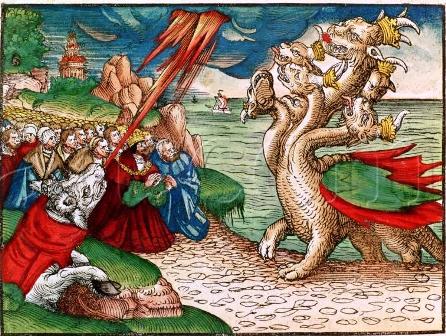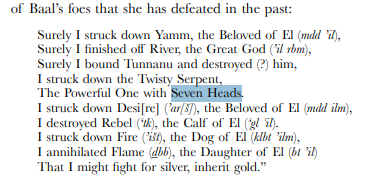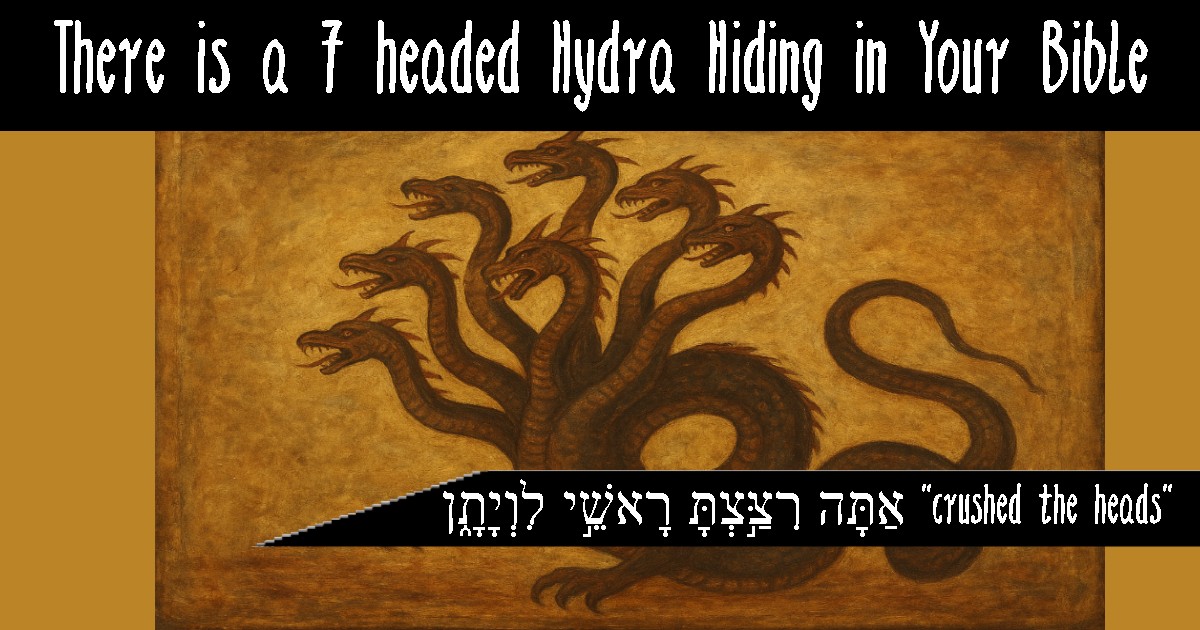How a Canaanite Sea Monster Invaded Scripture
Most Christians imagine Leviathan as just a poetic metaphor, some symbolic sea creature thrown into Scripture for dramatic flair, but the Hebrew text tells a far stranger story.
The biblical writers deliberately drew from an older Canaanite chaos-monster tradition, importing the multi-headed Hydra-like serpent (Leviathan לִוְיָתָן) straight into Israel’s sacred writings and repurposing it as Yahweh’s battlefield trophy. From Psalm 74’s “heads of Leviathan” (רָאשֵׁי לִוְיָתָן, plural) to Isaiah’s prophecy of Yahweh slaying “the twisting serpent” (הַנָּחָשׁ הַעֲקַלָּתוֹן), to Job’s fire-breathing beast, the Bible repeatedly echoes the Ugaritic Baal Cycle’s seven-headed sea-dragon Lotan a mythic chaos creature predating Israel by centuries.
The result is a shockingly transparent evolutionary line: a Canaanite hydra slithers into the Hebrew Bible, is subdued and rebranded by Yahweh, and eventually mutates again into later Jewish and Christian dragon mythology.
The Multi-Headed Monster of Psalms

Psalm contains a detail so direct that English translations often soften it with monster or Leviathan to re-cast it as a symbol of chaos, evil, and uncontrollable force instead of a mythical beast.
אַתָּה רִצַּ֣צְתָּ רָאשֵׁ֣י לִוְיָתָ֑ן
“You crushed the heads (plural: rāshê) of Leviathan.” Psalm 74:12–14
The Hebrew is explicit:
- רָאשֵׁי (rāshê) = “heads,” undeniably plural.
- The creature has multiple heads, not metaphorically but descriptively.
לִוְיָתָן (Liwyāṯān) = Root: לוה (L-W-H) – can mean “to twist,” “to coil,” or “to join/attach.”
reflecting the image of a serpent or sea monster that twists and coils. - This mirrors exactly the ancient Near Eastern image of a Hydra-like chaos serpent.
This verse alone destroys the idea that Leviathan was a whale, crocodile, or symbolic abstraction.
The text describes a polycephalic (multi-headed) creature.
The only other place this image exists in the ancient Levant?
Canaanite mythology.
Isaiah the Prophet Quoting Canaanite Legend
“In that day the Lord with his hard and great and strong sword will punish Leviathan the fleeing serpent, Leviathan the twisting serpent, and he will kill the dragon that is in the sea.” – Isaiah 27:1 (ESV)
In the Canaanite story of legends the Baal Cycle, the storm god Baal battles Lotan, a multi-headed sea serpent representing chaos and disorder, in a story that emphasizes Baal’s triumph as a cosmic victory over the threatening forces of the sea. This directly parallels Isaiah 27:1, where God defeats Leviathan, the twisting serpent, symbolizing chaos and opposition to divine order. Both texts use the imagery of a monstrous sea creature to dramatize the conquest of disorder, but while Baal’s victory reinforces the power of a Canaanite storm deity, Isaiah reinterprets the motif to highlight Yahweh’s supreme sovereignty, transforming a shared mythic symbol into a theological statement about God’s control over evil and cosmic forces.
Isaiah echoes language found verbatim in Ugaritic literature:
לִוְיָתָן נָחָשׁ בָּרִחַ – “Leviathan the fleeing serpent”
לִוְיָתָן נָחָשׁ עֲקַלָּתֹון – “Leviathan the twisting serpent”
הַתַּנִּין אֲשֶׁר בַּיָּם – “the dragon in the sea”
These three phrases are not generalized metaphors.
They are the precise mythic titles of the Canaanite chaos serpent Lôtan (ltn) recorded in the Ugaritic Baal Cycle.
The match is exact, linguistic and conceptual.
This means Isaiah is:
- drawing directly from Canaanite mythic vocabulary,
- applying it to Israel’s God,
- and reframing the chaos-combat motif (chaoskampf) around Yahweh.
This imagery closely parallels the Baal Cycle, where Baal defeats the sea-dragon Lotan, showing that Isaiah repurposes the ancient Canaanite chaos-monster motif to depict God’s sovereign victory over evil and disorder.
Leviathan of Job
The figure of Leviathan appears across multiple biblical texts, each time reflecting a different aspect of chaos and divine power. In Job 41, Leviathan is described in exhaustive detail as a fearsome, untamable sea creature with impenetrable scales, fiery breath, and immense strength. God challenges Job, emphasizing human powerlessness before such a force and highlighting that only God can control the chaos Leviathan embodies. Similarly, Isaiah 27:1 depicts God slaying Leviathan, the twisting serpent, framing the sea monster as a symbol of chaos and opposition to divine order. This mirrors motifs from the Baal Cycle, in which the Canaanite storm god Baal battles Lotan, a multi-headed sea serpent, to establish cosmic order. While the Baal Cycle emphasizes the triumph of a deity over a chaotic monster, the Hebrew Bible transforms the motif: Leviathan both demonstrates God’s unmatched power (Job) and symbolizes forces God will ultimately subdue (Isaiah). Together, these texts illustrate the adaptation of ancient Near Eastern mythic imagery into Israelite theology, showing both continuity with surrounding cultures and the distinctive theological emphasis on Yahweh’s sovereignty over creation and chaos.
The Baal Cycle: The Oldest Known Form of the Leviathan Hydra
The Baal Cycle, a group of Ugaritic texts from ancient Canaan discovered at Ras Shamra, dated 14th–13th centuries BCE, making it several centuries older than the earliest Old Testament writings.
The Ugaritic Baal cycle – Mark S. Smith (1994)
Theology of Baal: revisiting the interpretation of the Ugaritic Texts – Sanders, Susan (2003)

The myth of Baal battling the sea-dragon Lotan (the prototype of the biblical Leviathan) is widely recognized as the oldest known version of the hydra/sea-monster myth that later appears in the Old Testament.
The Canaanite tablets discovered at Ugarit (KTU texts) describe the god Baal fighting a monstrous serpent named Lôtan:
ltn btn brḥ — “Lotan, the fleeing serpent”
ltn btn ʿqltn — “Lotan, the twisting serpent”
šb rš — “the one with seven heads”

Source: KTU 1.5 I 1–3
The-Baal-Cycle.pdf
The-Ugaritic-Baal-Cycle-Volume-II.pdf
This is the earliest known mention of a seven-headed Hydra serpent in the Levant.
Now compare:
- Psalm 74 — Leviathan has multiple heads.
- Isaiah 27 — Leviathan is the fleeing serpent, the twisting serpent, the sea dragon.
- Ugaritic Baal Cycle — Lotan is the fleeing serpent, the twisting serpent, the seven-headed monster.
The correlation from the neighboring legend is too tight to be accidental.
The biblical writers were consciously reusing this mythic creature.
Why the Ancient Hebrew Authors Used a Hydra
The Hebrew Bible is not embarrassed to use mythological symbols.
Instead, it reclaims them.
The ancient Israelites lived among cultures where cosmic sea serpents symbolized:
- chaos
- disorder
- anti-creation forces
- rival divine powers
By portraying Yahweh as the one who crushes the Hydra, the biblical writers were making a political-theological claim:
Baal may be credited with defeating the sea-serpent in Canaanite religion,
but it is Yahweh—not Baal—who truly conquers chaos.
In other words, the biblical authors adopt existing mythic imagery to dethrone rival gods and elevate Yahweh as cosmic sovereign.
This is not myth removed.
This is myth reframed in service of monotheism.
Linguistic Evidence of Hydra Imagery in the Hebrew Bible
Several Hebrew terms signal the writers’ awareness of Near Eastern chaos-monsters:
לִוְיָתָן — Leviathan
Likely related to Ugaritic ltn, meaning “twisted” or “coiled.”
Functionally identical to Lôtan, the seven-headed Hydra-serpent.
תַּנִּין — tannin
Means “dragon,” “sea monster,” or “primordial serpent.”
Not zoological—mythological.
נָחָשׁ — nāḥāsh
In many texts, this refers to supernatural serpents, not ordinary snakes.
The Hebrew writers are using myth-technical vocabulary, not zoological description.
The Seven-Headed Beast Borrowed for Revelations
The multi-headed sea monster motif in ancient Near Eastern texts, including the Baal Cycle and the Hebrew Bible’s Leviathan was later adapted in the New Testament book of Revelation. Revelation 12:3 and 13:1 depict a seven-headed dragon rising from the sea, a clear evolution of the chaos-monster imagery. While Leviathan symbolizes God’s power over chaos, the Revelation dragon represents Satan and cosmic evil, with the multiple heads and horns emphasizing authority, menace, and widespread influence. This demonstrates how early mythic motifs were reinterpreted in a Christian apocalyptic framework, transforming a symbol of natural and divine power into one of spiritual and moral conflict.
Hydra Demonstrates the Hebrews Lived in a Mythic World
For many Christians, the shock is not that Leviathan exists—it’s that the biblical Leviathan is not original.
The multi-headed serpent precedes Israel, precedes Genesis, and appears in Canaanite literature centuries earlier.
The biblical writers did not sanitize their cultural environment.
Instead, they absorbed its mythology and repurposed it for theological dominance.
This means:
- The Bible is not myth-free.
- The Bible is not isolated from its environment.
- The biblical authors intentionally reused pagan mythic imagery to assert Yahweh’s superiority.
It reshapes how we see the ancient Israelite worldview. It reveals the Bible’s deep connection to surrounding cultures. It forces a confrontation with the mythic environment in which Scripture was written. It also exposes the creative, polemical strategy of the prophets and psalmists.
Rather than existing outside mythology, the Bible stands in active conversation with it, transforming older myths into declarations of Yahweh’s supremacy.
The Hebrew Scriptures deliberately incorporated one of the Near East’s most fearsome mythological creatures—and made Yahweh its conqueror.
References
- John Day, God’s Conflict with the Dragon and the Sea
- Mark S. Smith, The Origins of Biblical Monotheism
- Frank Moore Cross, Canaanite Myth and Hebrew Epic
- Michael D. Coogan, A Brief Introduction to the Old Testament

